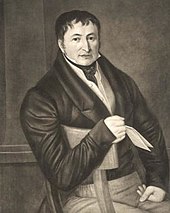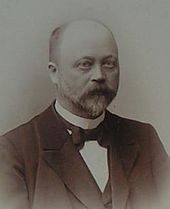List of personalities from Lutherstadt Eisleben
The following overview contains well-known personalities from Lutherstadt Eisleben .
sons and daughters of the town
Until 1800
- Gertrud von Helfta (1256–1301), mystic, saint of the Catholic Church
- Martin Luther (1483–1546), theologian and reformer
- Caspar Lindemann (1486–1536), medic
- Philipp Drachstedt († 1539 in Eisleben), mining and smelting entrepreneur, councilor of the Counts of Mansfeld and acquaintance of Martin Luther
- Johannes Agricola (1494–1566), reformer
- Michael Teuber (1524–1586), legal scholar
- Paul Crell (1531–1579), Lutheran theologian
- Caspar Schütz (≈1540–1594) Prussian historian
- Heinrich Compenius the Younger (≈1565–1631), organ builder
- Johannes Brever (1616–1700), Lutheran theologian
- August Wygand (1657–1709), lawyer, politician and writer
- Ludwig Christian Pezolt (1712 - after 1776), physician and city doctor of Nordhausen
- Andreas Weber (1718–1781), philosopher and Lutheran theologian
- Christoph Weber (1734–1787), physician, well doctor in Rehberg and Landphysicus in Walsrode
- Jacob Reineggs (1744–1793), adventurer and diplomat (actually Christian Rudolf Ehlich)
- Christian Heinrich Schmid (1746–1800), legal scholar, literary scholar and rhetorician
- Karl Ferdinand Schmid (1750–1809), legal scholar and ethnologist
- Gottlieb Lebrecht Spohn (1756–1794), educator, philologist and Protestant theologian
- Christian Gottlieb Berger (1764–1829), superintendent in Eisleben
- Carl Traugott Gottlob Schönemann (1765–1802), lawyer, philologist, professor in Göttingen
- Friedrich Gotthelf Benjamin Schmieder (1770–1838), classical philologist and high school teacher
- Friedrich Koenig (1774–1833), printer and inventor
- Johann Christian Ernst Ottiliae (1775–1851), mountain and hut clerk
- Carl Bernhard Trinius (1778–1844), physician, personal physician to the Russian Tsar
- Moritz Ernemann (1798–1866), piano teacher
1801 to 1900
- Karl Moritz Fleischer (1809–1876), pedagogue, high school teacher and publicist
- Friedrich August von Quenstedt (1809–1889), geologist and paleontologist
- Ernst Vogel (1810–1879), theologian and member of the Frankfurt National Assembly
- Hermann Ottiliae (1821–1904), Prussian mining captain
- Otto Heine (1832–1906), classical philologist, privy councilor and high school director
- Hermann Genthe (1838–1886), classical philologist, prehistorian and high school teacher
- Carl Fischer (1841–1906), worker and author
- Max Eschenhagen (1858–1901), geomagnetic
- Richard Böttger (1873–1957), SPD politician
- Thilo Krumbach (1874–1949), zoologist
- Max Schneider (1875–1967), music historian
- Max Hebecker (1882–1948), mining engineer and initiator of the so-called Wära miracle of Schwankirchen in the Bavarian Forest
- Werner Lindner (1883–1964), architect and one of the most important representatives of homeland security in Germany
- Kurt Wein (1883–1968), educator and botanist
- Karl Arthur Held (1884–1939), landscape painter
- Hermann Zickert (1885–1954), stock market pioneer
- Walter Alexis Karl Hoffmann (1891–1972), economist and university professor
- Hans Grund (1896–1976), major general
- Willy Knabe (1896–1967), painter, graphic artist and ex-libris artist
- Hermann Lindrath (1896–1960), CDU politician
From 1901
- Egbert Hayessen (1913–1944), major and resistance fighter of July 20, 1944
- Richard Rensch (1923–1997), organ builder and founder of the Rensch company based in Lauffen am Neckar
- Günther Steinacker (1926–2011), Protestant theologian
- Franz Uhle-Wettler (1927–2018), Lieutenant General in the Bundeswehr and military historian
- Jürgen Bräcklein (1938–2015), lawyer and politician (SPD)
- Ute Starke (* 1939), gymnast, world champion
- Burkhard Lasch (* 1940), musician, composer, producer, author and songwriter
- Lutz Teschner (* 1945), theater and film actor
- Thomas "Monster" Schoppe (* 1945), guitarist, composer and singer of the Klaus Renft Combo
- Jost Springensguth (* 1945), journalist
- Klaus-Peter Stieglitz (* 1947), Lieutenant General ret. D. of the Bundeswehr and 13th Inspector of the Air Force
- Hartmut Lauenroth (1950–2020), historian
- Monika Gibas (* 1951), historian
- Annette Vogt (* 1952), science historian
- Christel Hornstein (* 1954), journalist, social scientist and equal opportunities officer at the University of Wuppertal
- Eva-Maria Auch (* 1955), professor and orientalist
- Gudrun Berend (1955–2011), track and field athlete
- Birgit Keller (* 1959), politician (SED / PDS / Die Linke), member of the Thuringian state parliament, district administrator in the Nordhausen district
- Dolores Rente (* 1959), politician of the WASG / Die Linke
- Peter Gaffert (* 1960), forester and politician
- Tatjana Besson (* 1961), punk musician, a. a. with the band "Die Firma"
- Andreas Böttcher (* 1962), fusion and jazz musician
- Thomas Lange (* 1964), two-time Olympic champion in rowing
- Klaus Hartmann (* 1969), painter
- Timo Hoffmann (* 1974), professional boxer
- Marco Kurth (* 1978), soccer player
- Jana Bundfuss (* 1979), TV presenter and former porn actress
- Katja Wakan (* 1981), sprinter
- Annelie Brendel (* 1983), soccer player
- Norman Müller (* 1985), athlete
- Sandra Mikolaschek (* 1997), table tennis player
People connected to the city
- Hermann von Salm (1053-1088), also Count Hermann von Salm-Luxemburg, was anti-king Henry IV and resided from 1181 to 1184 in the Eisleber moated castle.
- Caspar Güttel (1471–1542), Lutheran theologian and reformer, died in Eisleben.
- Johann Spangenberg (1484–1550), Protestant theologian and reformer, died in Eisleben
- Michael Caelius (1492–1559), Lutheran theologian and reformer.
- Georg Major (1502–1574), Lutheran theologian, was superintendent here from 1550 to 1551.
- Urban Gaubisch (1527–1612), printer
- Thomas Hartmann (1548–1609), Protestant theologian and hymn poet.
- Johannes Förster (1576–1613), Lutheran theologian and general superintendent of the County of Mansfeld in Eisleben. Here he died too.
- Nicolaus Voigtel (1658–1713), geometer, mountain official and author, died in Eisleben
- Johann Anton Trinius (1722–1784), pastor, theologian and writer, lived and died in Eisleben
- Christian David Jani (1743–1790), Rector of the Royal High School and teacher at Novalis
- Novalis , actually Georg Friedrich Philipp Freiherr von Hardenberg (1772-1801), lawyer, mountain scientist, leading poet of early German romanticism, attended high school in 1790.
- Johann Carl Freiesleben (1774–1846), Saxon chief miner. Free life was appointed to Eisleben in 1800 as a mining commissioner and director of the Mansfeld mines. Here he presented several publications aimed at improving copper slate mining. In 1818 he donated 212 pieces from his geognostic mineral collection from the Freiberg area to the Prussian mountain school Eisleben.
- Ludwig Plümicke (1791–1866), mountain ridge, teacher, head of the Eisleben mountain school and honorary citizen of the city of Eisleben
- Eduard Fein (1813–1858), legal scholar, died in Helfta near Eisleben.
- Ernst Leuschner (1826–1898), Oberberg and Hüttenirektor, for whom in 1903 a memorial was erected.
- Hermann Großerler (1840–1910), teacher, local researcher and author of over 250 publications.
- Carl Eitz (1848–1924), acoustician and music teacher
- Carl Rühlemann (1864–1947), teacher, archaeologist, archivist, museum director, regional historian, author of 130, partly multi-part publications, member of the Hist from 1927 to 1934. Commission of the Province of Saxony u. for Anhalt, 1944 honorary citizen of Eisleben.
- Otto Richter (1865–1936), cantor and organist in Eisleben from 1890 to 1906, founded the Bachverein Eisleben in 1900, and from 1906 Kreuzkantor in Dresden.
- Karl Vogelsang (1866–1920), head of the mining and smelting works of the Mansfeld copper-slate-building union, was murdered by insurgent workers during the riots that followed the Kapp Putsch .
- Max Lademann (1896–1941) was a German politician (KPD). In 1933 he became a councilor in Eisleben. He was murdered in Sachsenhausen concentration camp in 1941. After the war, the secondary school at Rühlemannplatz in Eisleben was named after him and there is a memorial plaque on it. There is also Max-Lademann-Strasse in Eisleben .
- Werner Eggerath (1900–1977), politician, was district administrator (KPD) in 1945 and played a key role in the implementation of the land reform.
- Paul Berck (1912–1933), the so-called martyr of the Nazi movement, was shot in Eisleben.
- Ralph Wiener (* 1924) (bourgeois Felix Ecke) founded the “Bürgertheater”, the first German post-war theater, on July 13, 1945 in Eisleben.
- Fritz Wenck , was a theologian and resistance fighter against the Nazi regime. In 1934 and 1935 he and his wife Elfriede Wenck, born Denecke dissident leaflets to Eisleben. Both were arrested in 1937. After his imprisonment, Fritz Wenck was sent to Sachsenhausen concentration camp. He was murdered in 1945 on the death march from Sachsenhausen concentration camp to Bergen-Belsen concentration camp . Today (2010) a street in Eisleben is named after him.
- Hartmut Lauenroth (1950–2020), historian.
Individual evidence
- ^ Paul Tschackert: Trinius, Johann Anton . In: Allgemeine Deutsche Biographie (ADB). Volume 38, Duncker & Humblot, Leipzig 1894, p. 618 f.
- ↑ Entries on Hermann Großler. In: German National Library , accessed on August 6, 2016.
- ^ Helmut Plath : History of the City of Hanover. Vol. 1. From the beginning to the beginning of the 19th century. Edited by Klaus Mlynek , Waldemar R. Röhrbein . Schlueter, Hannover 1992, ISBN 3-87706-351-9 , p. 541.
- ↑ a b Stefanie Endlich, Nora Goldenbogen, Beatrix Herlemann , Monika Kahl, Regina Scheer : Memorials for the victims of National Socialism. A documentation. Volume II: Federal states of Berlin, Brandenburg, Mecklenburg-Western Pomerania, Saxony-Anhalt, Saxony, Thuringia. Edited by the Federal Agency for Civic Education . Bonn 1999, ISBN 3-89331-391-5 , p. 528 f.
- ^ Burga Kalinowski: Die hard. Funding cuts in theaters and orchestras threaten ensembles, cultural traditions and social structures of the stages in Halle, Dresden and Eisleben. In: new Germany. 29./30. March 2014, pp. 17–19 (with depictions of Felix Ecke = Ralph Wiener and the theater in Eisleben).
- ^ Hans Coppi junior : Hans Coppi on February 10, 2002 in Eisleben. Address on the anniversary of Eisleber's Bloody Sunday on February 10, 2002 in Eisleben. In: pds-mansfelder-land.de, accessed on August 6, 2016.







